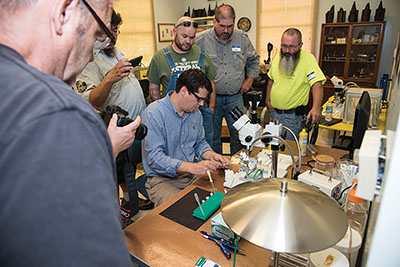
Instrumental insemination can seem overwhelming to most students at first, but with the proper training one can master the art and perform inseminations with confidence. Each year in early August bee breeders and researchers from around the country and abroad travel to Purdue University’s honey bee laboratory, where they learn how to instrumentally inseminate honey bee queens. Krispn Given is the principal instructor, an Apiculture Specialist and bee breeder, who teaches the short course “Instrumental Insemination and the Architecture of a Successful Breeding Program.”
The use of instrumental insemination (II) is important in controlling the parentage of particular crosses and maintaining desired traits like gentleness, disease resistance, VSH and mite-biting behaviors. This year we had 7 students come to the West Lafayette honey bee laboratory. Properly inseminating a queen requires much time and patience. Bee breeding requires constant observation for success, selecting for different desired traits from the honey bee (Apis mellifera) is a constant process; once you stop selecting you may lose some desired traits.
Once the student gets familiar with the sterile-technique and proper eversion of drones, it’s time to collect sperm. A drone bee typically produces 1 ul of measurable germplasm. All our drones are paint marked to know proper age and source. Sometimes when students practice inseminating a virgin queen, they can have trouble with the hydraulic system that controls the syringe or have too much air in the line or the C02 flow rate is too high. Setting up the instruments can also be somewhat difficult at first, especially fine tuning the light source. The course also teaches students how to care for II queens post insemination and how they can produce the highest quality drones.
Success is based on the individual student and the degree of training they received. For a course like this to be successful you need great people working with you behind the scenes. Matt Evans and Dorothy Morgan from Kentucky are fantastic beekeepers, who provided assistance with this year’s short course. They make sure it’s a success and make me look like I know what I am doing! They collect drones for the students and help out with all aspects involved in the instrumental insemination training process. THANK YOU!
Each of the 7 students successfully inseminated a queen and went home believing they could do it. That is what it is all about—empowering the student with knowledge. The interest in II has grown since first practiced in 1926, when Dr. Lloyd Watson demonstrated it successfully with the hand-help forceps method.
Here at Purdue we have developed bees that groom themselves free of disease-vectoring parasitic mites, another behavioral trait. Colonies that have a higher proportion of mites on their 24 hr sticky-boards due to grooming behavior tend to be the best mite-biters. We are currently conducting research in our lab to ameliorate honey bee health. Our recent CARE grant will allow us to continue to study and improve the mite-biter stock. The preliminary results look promising! The commercial sources we sampled had 3X more mites and overall winter mortality was 94% in comparison to the mite-biters that only suffered a 12% loss. We are also looking at less susceptibility to mortality due to viruses (DWV) that seem to occur in the mite-biters. We still see mites in our bees, just not as many as we did a decade ago. Overall our bees are starting to fight back!
We annually have breeders from seven states, mostly Midwesterners, who visit our bee lab and participate in the Heartland Honey Bee Breeders Cooperative (HHBBC). This group helps disseminate germplasm via descendants of “locally adapted” stocks that have demonstrated good winter survival and grow fewer mites, etc. We then perform crosses with our pure mite-biter stock (high % chewed mites x high % chewed mites). We call this event our insemination fest, which is open by invitation only. This year we inseminated about 60 breeder queens for these breeders. The idea is to get a diverse group of bees that share the same traits. We are also working with the Indiana Queen Breeders Association (IQBA) founded by commercial beekeeper David Shenfield to try and improve overall queen quality and help select bees that are genetically superior and above all survive cold IN winters. The IQBA has a system where they have Certified Bee Breeders and Queen Rearers.
Due to the growing interest in II and the lack of well manufactured equipment, we’ve created a US made insemination system. If you need custom insemination work or innovative insemination instruments made in the US and designed by Krispn Given and his business partner Mechanical Engineer, Dale McMahan, visit: https://apisengineering.com
Our insemination classes fill up quickly with 2019 already completely booked!


